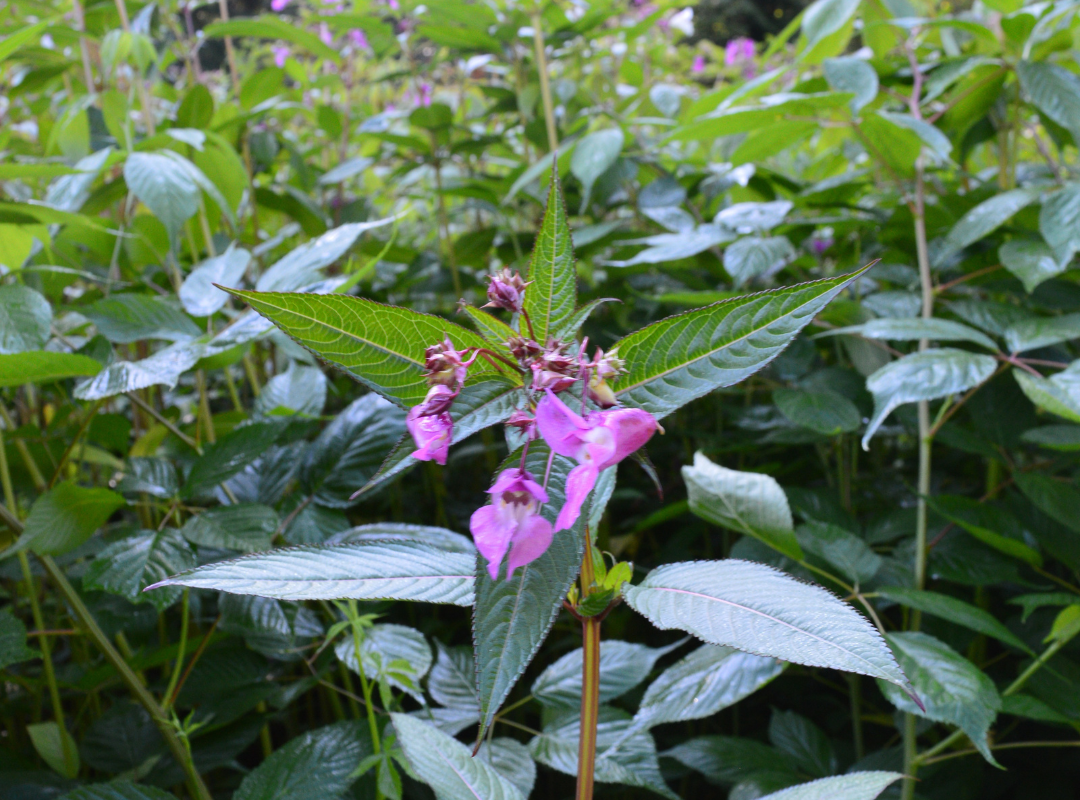Congratulations to our I Spy in the Sea to Sky giveaway winner Krystal Chin! Did you miss your opportunity to enter? Don’t worry, you have one more chance to win! Keep reading for contest details and to learn about this week’s mystery invasive species.
I’m a “touch-me-not” for my seed pods explode,
Spreading dense stands that cause soil to erode,
With shallow roots, I am satisfying to pull,
While I still have my police-helmet flowers, pink and full!

Unlike Himalayan Blackberry, Himalayan Balsam (Impatiens glandulifera) is actually from the (western) Himalayas and was introduced to North America in the 1900’s as a garden ornamental. Since then, it has taken over river edges, wetlands, and ditch banks. Indeed, it thrives in moist, shaded environments that contain nutrient-rich soils, like disturbed habitats and wet woodlands.

During the mid-late summer, Himalayan Balsam is easily spotted by its bright pink, purple, white, or red-ish flowers, resembling an old-fashioned police helmet. It has an exotic look with its pointed, oblong leaves, growing in groups of 3 along the stem. Its stems can reach a towering 3 m tall, which is impressive considering how they are hollow and easily broken – with a satisfying crunch!
While Himalayan Balsam is still sold and collected as a garden ornamental, this plant is extremely invasive due to its effective seed dispersal. When a seed capsule matures, it explodes (launching seeds up to 5 m away) and releases up to 2,500 seeds per plant. Himalayan Balsam loves growing near water, which means that its seeds easily get a free ride down flowing water, to pop up in new places downstream.
We love using patches of Himalayan Balsam for community weed pulls as its shallow roots make it super easy to pull! However, this means bad news in the wetland habitats that it invades. Himalayan Balsam will outcompete native species, perfectly suited for the habitat with extensive root systems, and replace them with a dense monoculture.
Populating riparian areas with a clump of shallow-rooted invasives means one thing – erosion! To make it worse, Himalayan Balsam is an annual and as it dies back in the fall, it exposes river banks to the elements, which increases erosion through the winter.
Next time you see Himalayan Balsam, start pulling – and dispose of it in the garbage, of course. This will help make room for the native species to repopulate their native habitat. Be sure to report sightings as SSISC is working to strategically control infestations of Himalayan Balsam in the Squamish area, and eradicate infestations in Whistler and Pemberton areas.

I Spy in the Sea to Sky Contest
It’s your last month to guess the invasive species in our I Spy in the Sea to Sky weekly social media post, to enter the giveaway. At the end of each month, one lucky commenter will win a Native Wildflower seed mix packet!
Contest Rules:
- Comment your guess (common name or species name) on either Facebook or Instagram post to enter
- One entry per person per post
- Anyone can play, but only residents of the Sea to Sky region are eligible to win (as prizes will be delivered)
- Content entries will close at 11:59 PM PST on the last day of the month
- Winners will be announced in the first week of the following month on the SSISC Instagram story and contacted via their platform of entry



Add Comment